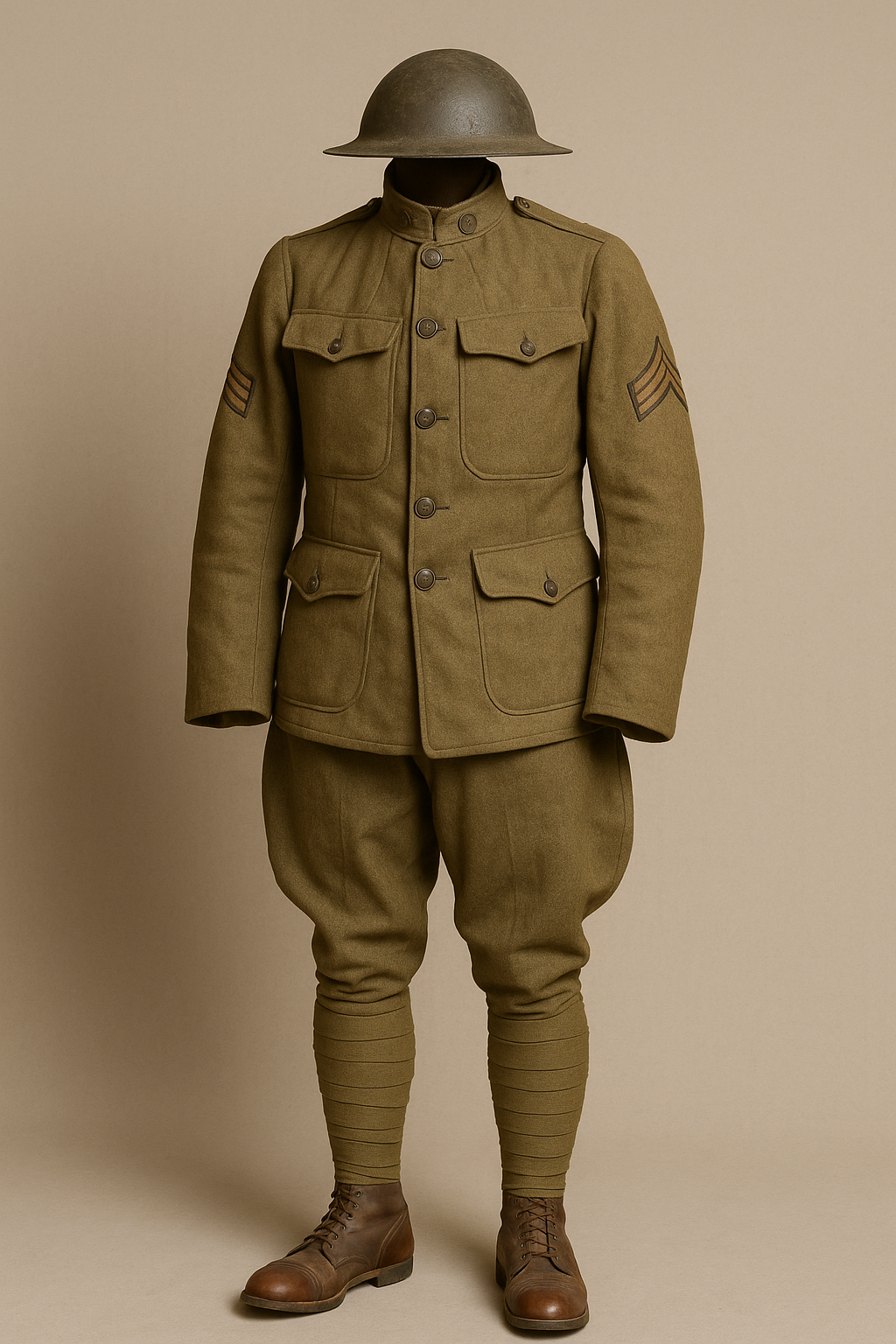
American Army Uniform History: A Beginner’s Guide to WWI Uniform Collecting
Published on Oct 01, 2025
American Army Uniform History: A Beginner’s Guide to WWI Uniform Collecting
Did you know that original WWI American uniforms can sell for thousands of dollars at auction?
Collectors, historians, and even reenactors are fuelling a rising interest in WWI uniform collecting, with the most sought-after pieces becoming rare treasures.
If you’ve ever been fascinated by vintage military gear, particularly American Army uniform history, diving into WWI uniform collecting is an exciting and rewarding hobby. From decoding rank patches to preserving a French WW1 greatcoat, there’s a lot to uncover—and it starts here.
Why WWI Uniform Collecting is Booming
Collecting WWI uniforms is more than just owning old clothes—it’s about preserving history. The First World War was a turning point in military technology, tactics, and gear. Uniforms from this era reflect a mix of 19th-century tradition and early modern warfare innovation.
What Makes These Uniforms So Valuable?
- Scarcity – Many uniforms were destroyed, reused, or deteriorated.
- Craftsmanship – WWI gear was made to last with wool, leather, and brass.
- Historical importance – Each piece tells a story of the Great War.
Today, collectors seek authenticity, uniqueness, and condition. Uniforms of aviators, medics, or trench soldiers each offer different stories—and price points.
American Army Uniform History: Understanding the Basics
When it comes to WWI uniform collecting, knowing your American army uniform history is essential.
Key Uniform Components from WWI:
- Wool Service Coat (M1917) – The standard issue for American Doughboys.
- WW1 Pants (Trousers, M1912/1917) – High-waisted with lace-up cuffs, typically made of wool.
- Puttees – Long cloth strips wrapped around the lower legs.
- WW1 Flying Jacket (Aviator’s Gear) – Worn by American and Allied pilots, made of leather or heavy wool.
- Steel Helmet (M1917 Brodie Helmet) – Inspired by British design.
These uniforms were functional, simple, and adapted from European styles.
Collector Tip:
Look for manufacturing stamps, soldier ID tags, and original buttons to verify authenticity.
Getting Started: How to Begin Your WWI Uniform Collection
You don’t need to be a historian or millionaire to start collecting. Follow these practical steps to begin.
1. Choose a Focus
Narrow your interest to avoid being overwhelmed:
- Specific army (e.g., American, British, French)
- Branch (e.g., infantry, medical, aviation)
- Era (WWI vs. WWII vs. interwar)
2. Learn the Visual Details
Study uniforms in museum catalogues or online databases. Focus on:
- Stitching and fabric
- Button shapes and stamps
- Color shades (OD green vs. khaki)
3. Set a Budget
Prices range widely:
- $50–$150: WWI pants, small accessories (puttees, insignias)
- $200–$600: Service coats or basic sets
- $1000+: Full uniforms, aviation jackets, rare pieces
4. Buy from Trusted Sources
Start with reputable sellers:
- Military antique shops
- Historical auctions
- Online platforms like eBay (check ratings and returns)
- Facebook groups and forums for collectors
Spotting Authentic WWI Uniforms: What to Look For
Identifying Real from Reproduction
Reproductions are common, especially for reenactments. Here's how to spot the real thing:
Check for:
- Original tags (quartermaster stamps with date)
- Wool weight and weave (modern wool is often lighter)
- Aged leather smell and texture
- Stitching and hand-finished details
Be cautious of:
- “Mint condition” items with no wear
- Plastic buttons or Velcro
- Missing provenance
American Army Uniform History: Pieces That Define an Era
The American Army uniform history during WWI stands out for its blend of practicality and influence from European allies.
Examples of Iconic Uniforms:
1. The M1917 Service Coat
- Olive drab wool
- Stand-and-fall collar
- Patch pockets and brass buttons
- Often found with sergeant or corporal rank patches
2. WW1 Flying Jacket
- Shearling or heavy leather
- Often personalized by pilots
- Rare and highly collectible
3. French WW1 Greatcoat
- Adopted by American volunteers before U.S. standardization
- Double-breasted, heavy wool
- Distinct horizon blue color
4. First World War British Uniform
- Worn by American Expeditionary Forces (AEF) units integrated with British command
- Includes P08 webbing and Brodie helmets
Common Pitfalls to Avoid in WWI Uniform Collecting
Even seasoned collectors get burnt. Here are mistakes to avoid:
- ❌ Buying without research – Don’t rush. Check references.
- ❌ Falling for ‘too good to be true’ deals – Especially on online marketplaces.
- ❌ Skipping provenance – Always ask for background info or documentation.
- ❌ Ignoring condition issues – Moth damage and mould can spread to other items.
- ❌ Poor storage – Store uniforms in cool, dry environments with acid-free materials.
Current Trends in WWI Uniform Collecting
What’s Hot Right Now?
- Pilot and Aviation Gear – WW1 flying jackets and pilot goggles are in demand.
- Named Items – Uniforms linked to specific soldiers or battles.
- Multinational Collections – Collectors are mixing American, British, and French pieces.
- Restoration Projects – Carefully restoring uniforms with original materials is gaining popularity.
Digital Collecting
- High-resolution scans of WWI documents and uniforms
- Virtual displays and online forums
- Collectors sharing items via YouTube and Instagram
American Army Uniform History: Bringing the Past to Life
WWI uniform collecting brings history out of books and into your hands. Whether it’s a pair of authentic WW1 pants, a battle-worn French WW1 greatcoat, or a complete First World War British uniform, each item helps us understand the personal stories of soldiers from over a century ago.
